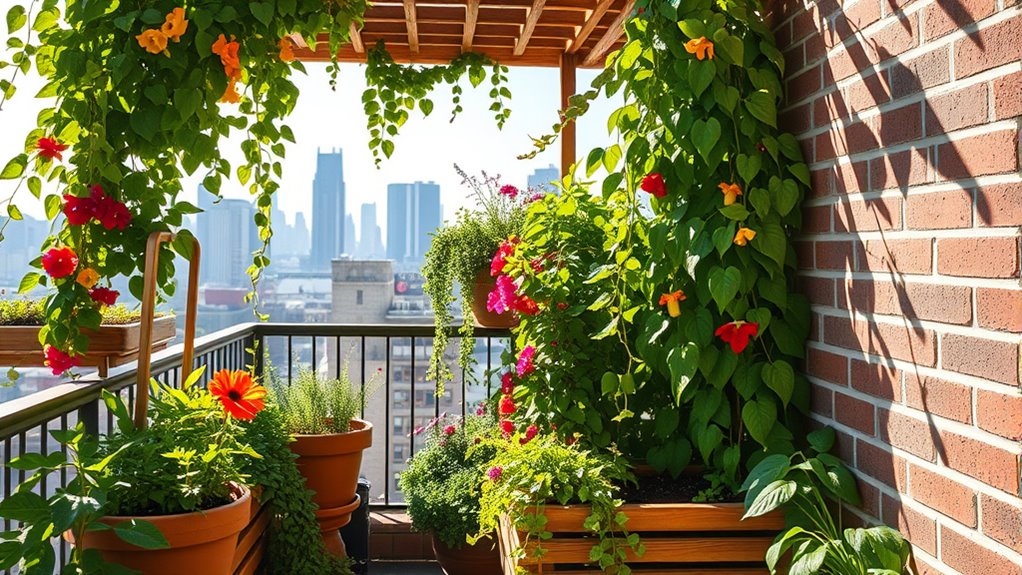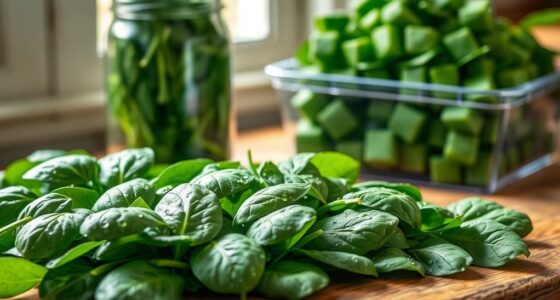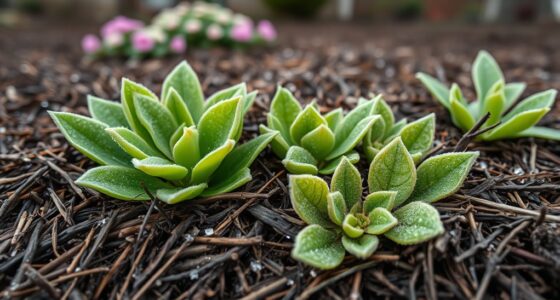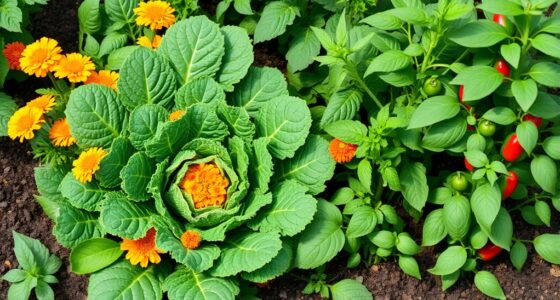If you're looking to maximize space, growing vertical gardens is the perfect solution. You can transform bare walls or small balconies into lush green spaces by using climbing plants, leafy greens, and compact flowers. These gardens not only enhance your home's aesthetics, but they also improve air quality and require minimal maintenance. With the right setup and plant selection, you can easily create a thriving vertical garden. Discover creative design ideas and essential maintenance tips to keep your garden flourishing.
Key Takeaways
- Vertical gardens maximize limited space by utilizing walls and vertical structures for plant growth, making them ideal for small areas.
- Select compact and climbing plants to efficiently use vertical space while ensuring a diverse and visually appealing garden.
- Use wall-mounted planters and hanging pots to create a dynamic garden layout that can be adjusted seasonally for continued interest.
- Implement a drip irrigation system for effective watering, as vertical gardens require more frequent moisture than traditional setups.
- Regular maintenance, including nutrient assessments and pest monitoring, ensures a healthy and productive vertical garden in limited spaces.
Why Choose Vertical Gardening?

Why choose vertical gardening? If you're short on space to grow plants, vertical gardening systems could be your perfect solution. This innovative approach allows you to maximize every inch of your area, transforming bare walls and small balconies into lush green displays.
Plus, the benefits of growing vertically extend beyond aesthetics. These gardens enhance indoor air quality by filtering pollutants and boosting oxygen levels, creating a healthier living environment.
Vertical gardens not only beautify your space but also improve air quality, making your home healthier and more vibrant.
Maintenance is a breeze, requiring minimal watering and care once established, making it ideal for busy lifestyles. By growing upwards, you also reduce the risk of disease associated with ground moisture, leading to healthier, more productive plants.
Embrace vertical gardening and enjoy a vibrant, green oasis in your home!
Selecting the Best Plants for Vertical Growth

When selecting plants for vertical growth, you'll want to take into account varieties that thrive in limited space, like climbing beans and compact herbs.
Think about their growth requirements to guarantee they flourish in your setup.
Balancing aesthetics with practicality will help you create a vibrant and functional vertical garden. Additionally, consider using self-watering planters to simplify maintenance and ensure consistent moisture for your plants.
Ideal Plant Varieties
Have you ever wondered which plants thrive best in vertical gardens? Choosing the right varieties can make all the difference. Climbing plants like cucumbers, tomatoes, and pole beans utilize vertical space efficiently. Leafy greens such as lettuce and spinach have shallow roots, making them perfect candidates too. Don't forget about container plants—herbs like basil, parsley, and mint grow quickly and fit perfectly in small spaces. Vining flowers like sweet peas add beauty and visual interest, while small fruiting plants like strawberries thrive in vertical systems.
Here's a quick comparison:
| Plant Type | Examples |
|---|---|
| Climbing Plants | Cucumbers, Tomatoes, Beans |
| Leafy Greens | Lettuce, Spinach |
| Container Plants | Basil, Mint, Strawberries |
Growth Requirements Considerations
Selecting the right plants for vertical gardens involves understanding their growth requirements. Focus on plants to grow that have shallow root systems, like leafy greens, herbs, and annual flowers, as they thrive in limited soil depth.
Climbing plants, such as peas, cucumbers, and pole beans, are perfect for growing vertically, as they naturally reach for the sky and can be supported on trellises. Pay attention to light requirements; ferns and certain succulents can flourish in lower light, making them great for indoor setups.
Mixing various plants enhances visual interest while grouping those with similar water needs simplifies maintenance. Opt for compact varieties, like cherry tomatoes or mini watermelons, for a successful vertical gardening experience without using excessive space. Additionally, ensure you have a backup water container to support your plants, especially during dry spells.
Aesthetic and Practical Choices
While creating a vertical garden, choosing plants that are both aesthetically pleasing and practical is key to maximizing your space.
Compact herbs like basil, parsley, and mint are excellent for growing plants since they thrive in vertical gardens and offer culinary benefits. Climbing plants such as cucumbers and tomatoes can utilize trellises, enhancing your garden's yield without taking up much ground area.
Don't forget about succulents like echeveria, which add unique shapes and colors with minimal maintenance. Annual flowers and leafy greens, including lettuce and spinach, contribute visual interest, while trailing plants like philodendrons provide lush greenery and cover structures beautifully.
Selecting the right mix can transform your vertical garden into a functional and eye-catching space.
Essential Steps to Set Up Your Vertical Garden
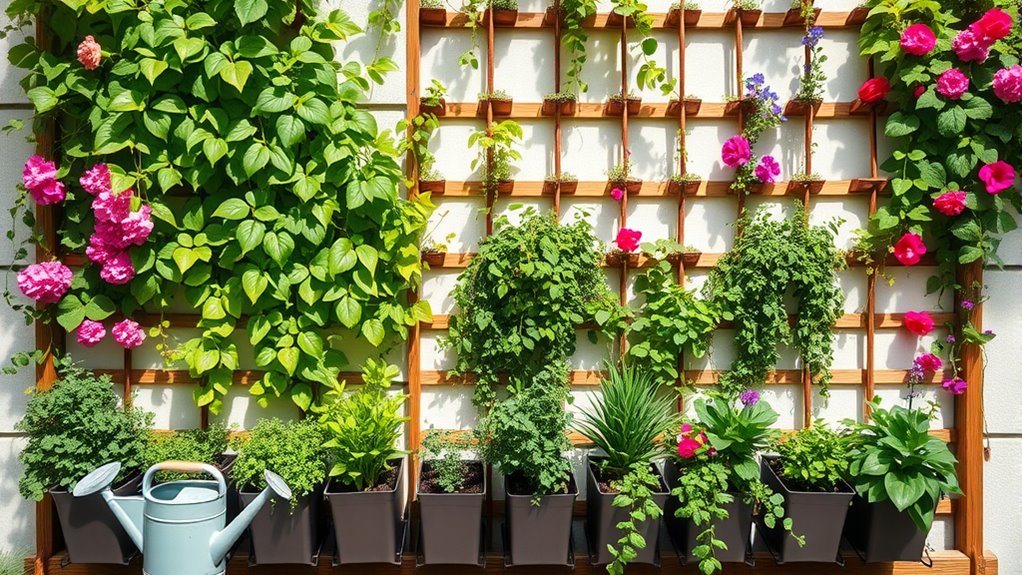
Creating a vertical garden involves a few essential steps that can transform your space into a vibrant green oasis.
Start by selecting a suitable vertical growing system, like wall-mounted planters or hanging pots, to maximize space efficiently. Confirm your containers have proper drainage by adding a layer of gravel, followed by nutrient-rich soil, especially for herbs and flowering plants.
Choose plants that thrive in your light conditions, focusing on compact varieties such as herbs, ferns, or trailing vines. Arrange your plants based on similar light and water needs to make maintenance easier.
Finally, regularly monitor your garden, adjusting watering and pruning as needed to promote peak plant health and productivity in your vertical garden.
Advantages of Vertical Gardening in Small Spaces
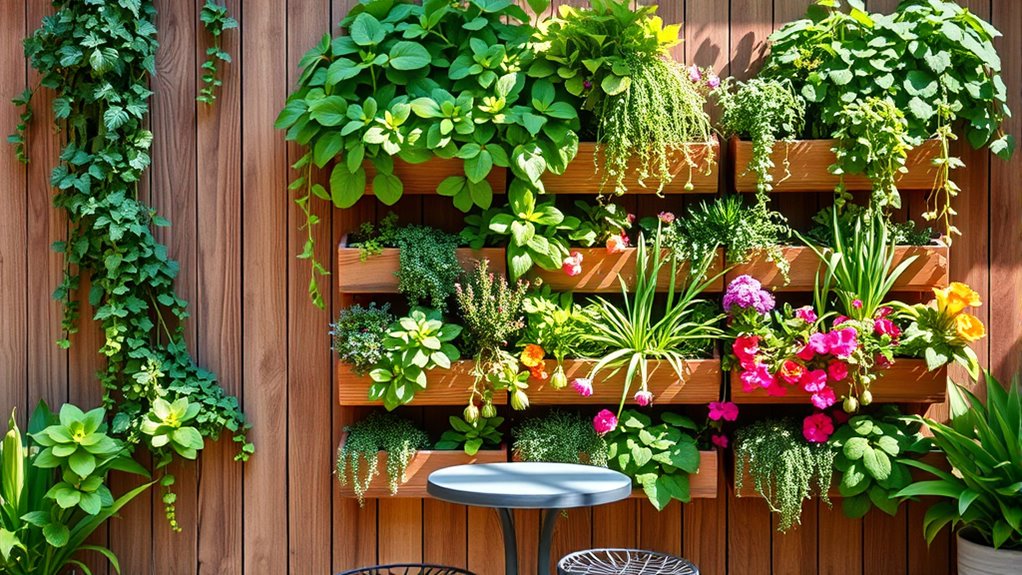
If you've got limited horizontal space, vertical gardening offers an innovative solution that transforms your small areas into vibrant green havens.
By utilizing wall-mounted systems and vertical structures, you can grow a variety of plants, from herbs to vegetables. This approach boosts space efficiency, allowing you to cultivate more plants in less area—often yielding up to 30% more produce compared to traditional gardening.
Not only does vertical gardening maximize your growing potential, but it also enhances the aesthetic appeal of your living space, acting as a living art piece.
Plus, with design flexibility, you can create lush arrangements that improve indoor air quality while turning compact areas into beautiful green retreats.
Creative Ideas for Vertical Garden Designs
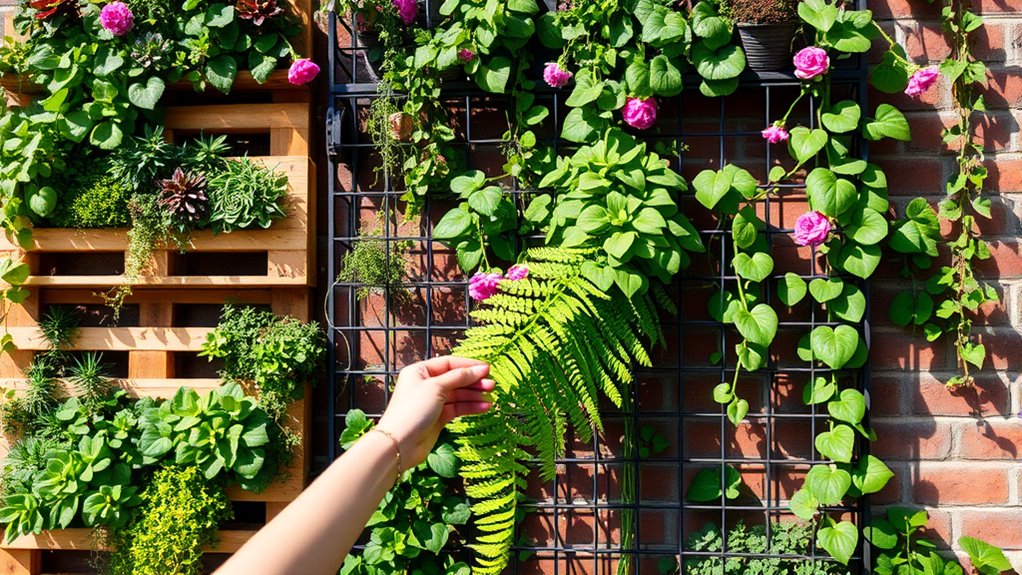
Vertical gardening opens up a world of creative possibilities for transforming your space into a lush oasis.
You can easily utilize pallet planters to grow herbs and leafy greens, making it a budget-friendly vertical garden indoors.
Repurpose plastic bottles to create unique hanging baskets that not only save space but also reduce waste.
Transform plastic bottles into creative hanging baskets, maximizing space while promoting sustainability in your vertical garden.
Wall-mounted containers are perfect for growing different plants, adding both beauty and functionality to your home.
If you're limited on space, stackable planters provide an efficient solution, allowing you to cultivate multiple varieties.
Consider incorporating vertical hydroponic systems for a soil-free growing method, ideal for producing leafy greens and herbs.
With these ideas, your vertical garden will flourish in style!
Maintaining Your Vertical Garden Throughout the Seasons
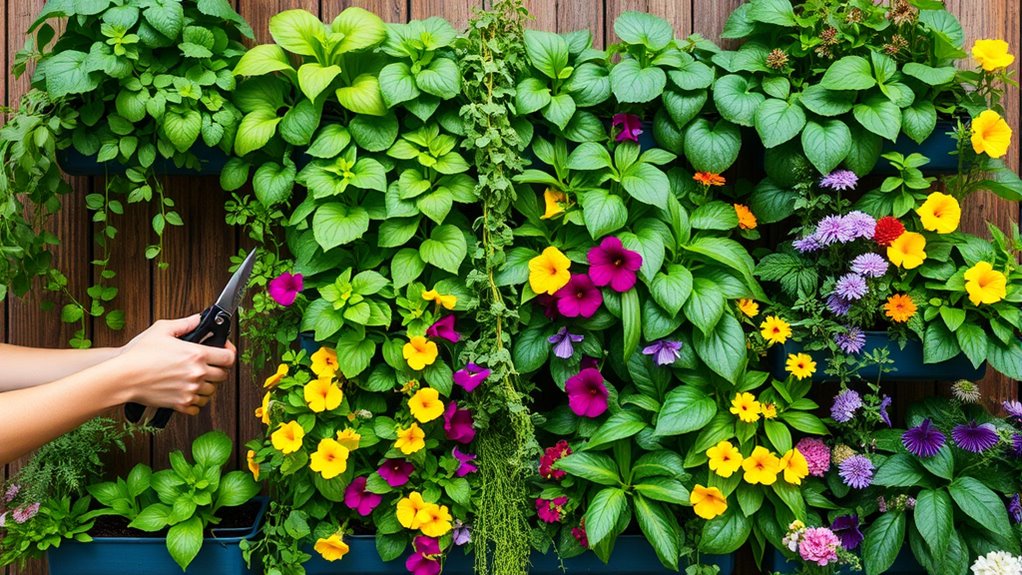
Maintaining your vertical garden requires attention to seasonal changes, from adjusting your plant selection to monitoring watering and nutrient needs.
As temperatures shift, you'll need to watch for pests and diseases that can impact your plants' health.
Staying proactive will guarantee your garden thrives through every season.
Seasonal Plant Adjustments
As seasons change, adjusting the plants in your vertical garden becomes essential to guarantee they thrive in varying conditions.
For fall and winter, consider adding hardy plants like leafy greens, herbs, and root vegetables. These can withstand cooler temperatures and continue to flourish in sheltered setups.
When spring and summer arrive, switch to warm-weather crops such as tomatoes, cucumbers, and beans, which love the increased sunlight and longer growing seasons.
Regularly monitor your vertical garden for plant health, making necessary seasonal plant adjustments to layouts and combinations.
Utilize these changes to experiment with different plant combinations, maximizing both space efficiency and visual appeal year-round.
Keeping your garden dynamic will make certain it remains vibrant and productive throughout the seasons. Additionally, incorporating personal touches such as decorative plant markers can enhance the aesthetic appeal of your vertical garden while providing practical benefits.
Watering and Nutrient Needs
When it comes to keeping your vertical garden thriving, understanding its watering and nutrient needs is vital.
Vertical gardens typically require more frequent watering than traditional ones, so checking daily, especially in hot weather, is advisable. A drip irrigation system can efficiently deliver water directly to the roots, ensuring consistent moisture levels while minimizing waste.
Additionally, nutrient-rich soil is important for your plants' health. Applying a balanced fertilizer every 4-6 weeks helps maintain their growth and productivity.
Keep an eye out for signs of nutrient deficiencies, like yellowing leaves or stunted growth, to adjust your fertilization and watering practices.
Pest and Disease Management
To keep your vertical garden healthy and vibrant, it's essential to stay vigilant about pest and disease management throughout the seasons. Here are some effective strategies:
- Regular Inspections: Check for pests like aphids and spider mites, which thrive in humid, confined spaces.
- Organic Pest Control: Use beneficial insects like ladybugs or neem oil to minimize chemical use and protect the environment.
- Monitor Diseases: Guarantee proper spacing for air circulation to prevent issues like powdery mildew and root rot.
- Companion Planting: Plant marigolds near vegetables to naturally repel pests like nematodes and aphids.
Frequently Asked Questions
How Do You Save Space in Vertical Gardening?
To save space in vertical gardening, you can utilize structures like trellises and shelves to maximize vertical growth.
Choose climbing plants such as peas and cucumbers that naturally grow upward.
Stack pots or use tiered stands for efficient organization, ensuring plants thrive without overcrowding.
Incorporate hanging baskets and wall-mounted containers for additional planting areas.
Finally, get creative with materials like repurposed pallets to create budget-friendly vertical solutions that enhance your garden's productivity.
Are There Any Drawbacks to Using Vertical Gardens?
Yes, there are drawbacks to using vertical gardens.
You'll find they often require a higher initial investment for materials and can demand more maintenance, like frequent watering and monitoring.
Additionally, limited root space might restrict the size and variety of plants you can grow.
You'll also need to choose plants carefully to meet their light and water needs, and accessing taller structures for harvesting can be challenging without proper tools.
Is It Difficult to Maintain Vertical Garden?
Maintaining a vertical garden isn't too difficult once it's established.
You'll find that many plants, like succulents and herbs, thrive with minimal watering. Regularly checking for pests is essential, but the height helps reduce moisture issues.
Plus, the design makes it easier for you to access plants for pruning or harvesting. If you incorporate self-watering systems, you'll spend even less time on maintenance, ensuring your garden stays healthy and vibrant with less effort.
What Plants Grow Well in a Full Sun Vertical Garden?
In a full sun vertical garden, you'll find that vibrant tomatoes like 'Sun Gold' and 'Patio Princess' thrive beautifully.
Heat-tolerant peppers, such as 'Cayenne' and 'Jalapeño,' love the sun too and can be easily trained to climb.
Climbing cucumbers, like 'Tasty Green,' flourish, while vining annual flowers, including 'Morning Glory,' attract pollinators.
Don't forget herbs like basil and rosemary; they not only thrive in sunlight but also enhance your culinary creations!
Conclusion
So, you thought you needed a sprawling backyard to enjoy gardening? Ironically, with vertical gardening, you can turn your tiny balcony or even a bare wall into a lush paradise. By embracing the upward growth of plants, you not only save space but also create a stunning green haven. With just a little creativity and care, you'll find that even the smallest spaces can thrive, proving that sometimes, less really is more when it comes to gardening.

